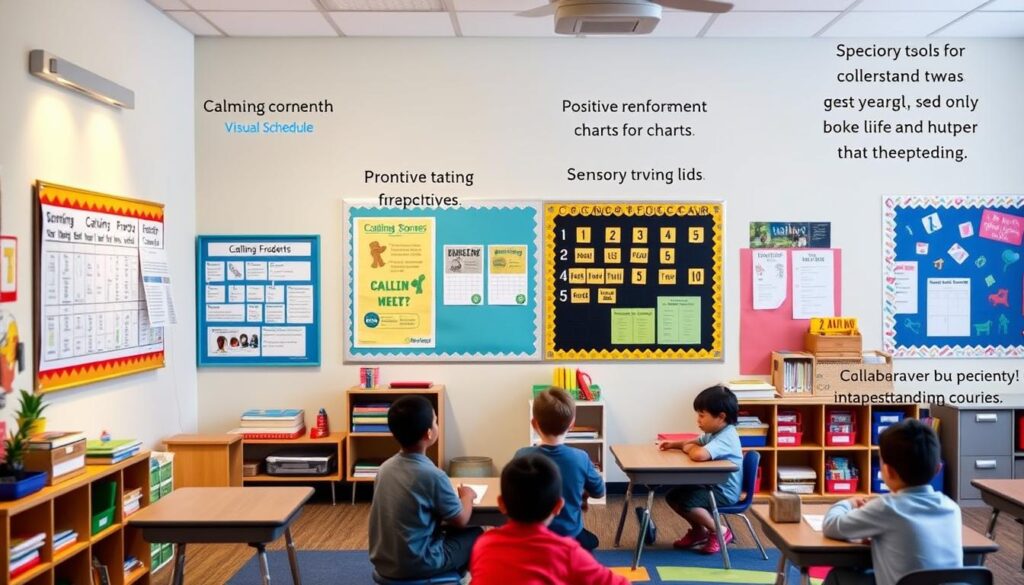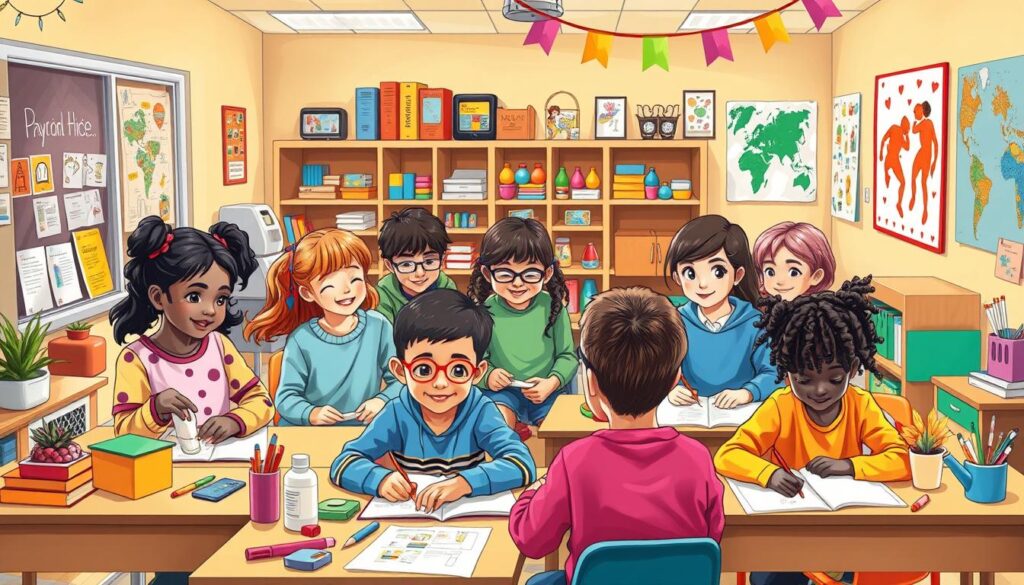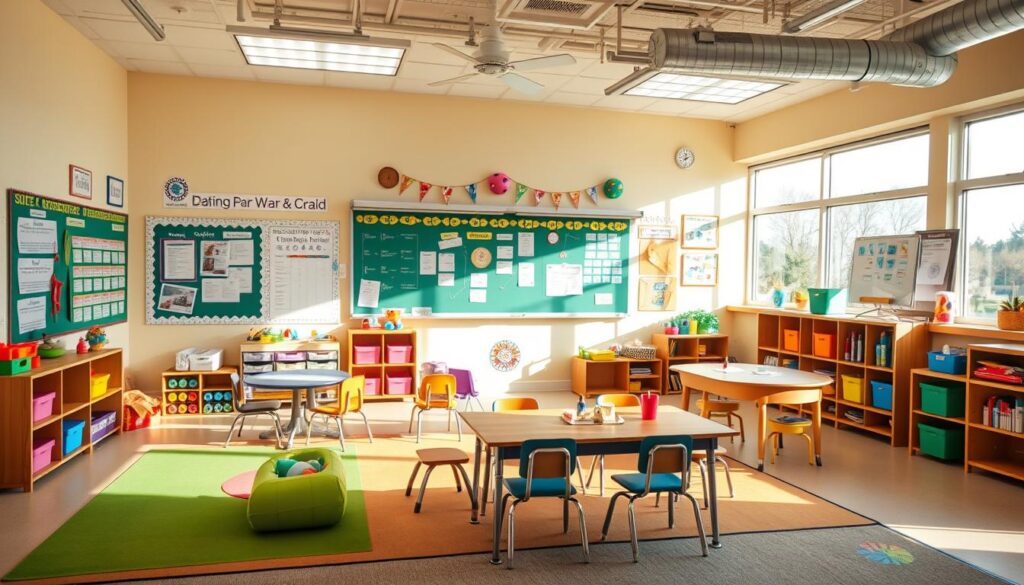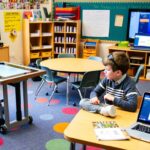Did you know classrooms lose 144 minutes of learning time each week because of bad behavior? This shows how important good behavior management is in special education. Here, 13% of students need special help, which means we need special strategies for them.
In this tough setting, it’s key to have clear rules for students with disabilities. This helps them do well in school and grow emotionally. Positive behavior support in special education makes classrooms better and helps teachers and students get along.
Looking closer at this topic, we see that we need strong strategies. By focusing on behavior management, we can make school better for everyone. Let’s see how good behavior management can change our classrooms for the better.
Key Takeaways
- Bad behavior can cause a lot of lost learning time, so managing it is very important.
- A big number of students get special education, showing they need special plans.
- Being positive with students helps them join in more in class.
- Having clear rules helps students stay focused and behave better.
- It’s key to build good relationships with students to understand them better.
- Creating structured environments can help reduce bad behavior.
Understanding the Importance of Behavior Management in Special Education
Managing behavior in special education is key to better learning. Students with special needs face unique challenges. These can include communication issues, sensory sensitivities, or learning disabilities.
These challenges can cause behavior problems. These problems affect not just the student but the whole classroom.
The impact of behavior disruptions on learning outcomes
Behavior disruptions really hurt learning. When there are interruptions, learning stops. This makes students and teachers frustrated.
It limits chances for students to learn and grow. Studies show that good behavior management helps. It builds positive relationships and makes students more willing to cooperate.
Statistics on instructional time lost
Behavior problems cost a lot of learning time. Teachers lose about 144 minutes each week to classroom disruptions. Teaching could take place during this period.
By using the right behavior management, we can save this time. For everyone, this improves the learning environment.

Building Meaningful Relationships with Students
Building strong relationships with special education students is key to a good learning environment. These connections help students feel safe and trusted. This, in turn, improves their behavior.
Dr. Charles Basch’s research shows that good teacher-student relationships make students feel safer at school. They also miss school less often. When students feel valued, they do better in school.
How relationships influence student behavior
Relationships greatly affect how students behave. By connecting with my students, I see them take fewer risks and become more resilient. Sharing experiences strengthens these bonds.
Just three minutes a day can make a big difference. Being real and sharing personal interests helps build strong relationships. This creates a positive classroom atmosphere.
Strategies for connecting with students
- Start each day by greeting students warmly.
- Check in regularly, asking open-ended questions about their interests and activities.
- Praise students publicly while correcting them in private for better relationship building.
- Engage in restorative conversations to maintain and repair relationships after conflicts.
- Utilize an engaging and motivating behavior plan that encourages positive interactions.
- Encourage vulnerability by asking for assistance, which builds trust.

It’s getting harder to build healthy relationships with students. Loneliness among teens shows we need to focus on connecting with them. But, I believe the effort is worth it for a better learning environment.
| Strategy | Description | Effect on Students |
|---|---|---|
| Daily Check-ins | Regularly engage with students about their interests. | Increased feelings of being valued. |
| Public Praise | Acknowledge successes in front of peers. | Boosts confidence and morale. |
| Restorative Conversations | Discuss issues openly to repair relationships. | Encourages accountability and understanding. |
| Mutual Interests | Share personal stories and interests. | Enhances authenticity and connection. |
Behavior Management in Special Education: Establishing Clear Expectations
Clear expectations are key in special education. They assist students in understanding expectations. This reduces confusion and behavioral problems. I make sure to follow rules and routines closely in my classroom.
This approach creates a positive space for students to learn and grow.
The importance of rules and routines
Rules and routines are very important. Studies show that classes with clear rules have fewer disruptions. This shows how crucial it is to have clear expectations in special education.
I suggest having 3-5 simple, positive rules. These rules should apply to most lessons. Examples include staying seated and raising your hand to ask questions.
- Staying in your seat
- Raising your hand to ask questions
- Using polite language
- Asking for help when needed
For specific activities, like downtime or recess, I set additional rules. Students with special needs do well with structured routines. Regular schedules and clear transitions help reduce bad behavior.
Methods to communicate expectations effectively
It’s important to communicate expectations clearly. Visual aids like schedules and cues help students understand. These resources are particularly useful while things are changing.
I also employ prizes and praise as forms of positive reinforcement. This encourages good behavior. By recognizing good actions, students are more likely to keep doing them.
Working with support staff and parents is also key. It helps keep behavior management consistent. Anticipating and preventing problems is another important strategy.
| Behavioral Strategy | Description | Benefit |
|---|---|---|
| Visual Supports | Visual schedules and cues to aid understanding | Improved transition and clarity |
| Positive Reinforcement | Verbal praise and reward systems | Encouragement of appropriate behaviors |
| Structured Routines | Consistent schedules throughout the day | Reduction in disruptive behavior |
| Proactive Strategies | Anticipation of triggers and modifications | Prevention of challenging behaviors |
| Collaboration | Communication with support staff and parents | Enhanced consistency and effectiveness |
Creating a Positive Learning Environment
A positive learning environment is key for students in special education to do well. I use effective strategies to help students engage and meet their diverse needs. A supportive classroom atmosphere encourages students to participate and manage their behavior well.
Strategies for fostering engagement
To boost engagement, I use different teaching methods for various learning styles. Hands-on activities, visual aids, and technology make lessons more fun. Clear expectations and a consistent routine help students succeed.
Positive reinforcement for good behavior helps students participate more and reduces disruptions. This approach is very effective.
Accommodations to meet diverse needs
It’s important to provide accommodations for different learning needs. Flexible seating makes the classroom more comfortable, helping students focus. Regular breaks reduce anxiety and improve learning by preventing overwhelm.
Individualized supports, like positive behavior plans, help students with unique challenges succeed. Working with families ensures these strategies are used everywhere, supporting student growth.
Implementing Effective Classroom Behavior Management Strategies
Managing classroom behavior is key to a productive learning space. Using effective strategies helps with smoother transitions and keeps focus on learning. By combining different techniques, I can tackle disruptions and support students well.
Techniques for managing behavior disruptions
Active supervision is a powerful tool. Being present and attentive helps prevent misbehavior and boosts engagement. It’s also crucial to clearly communicate what’s expected. This way, students know their role and are less likely to misbehave.
Positive reinforcement is another effective method. Recognizing good behavior motivates students. Getting students involved in setting classroom rules also builds a sense of community and responsibility.
The role of structure and routine in behavior management
Structure and routine are vital in special education. They reduce anxiety and behavioral issues. Research shows students do better in clear and consistent environments.
Consistently enforcing and reviewing rules helps prevent disruptions. A structured environment encourages positive engagement with peers and tasks. This approach helps students thrive.
Utilizing Behavior Intervention Plans (BIPs)
Behavior Intervention Plans (BIPs) are a structured way to help students with challenging behaviors. They define specific strategies to address these issues. Creating effective BIPs requires understanding key components for success in special education.
Components of a successful behavior intervention plan
A successful BIP has several parts that work together. These parts are:
- Identification of Target Behaviors: Clearly defining which behaviors need to be addressed.
- Functional Behavioral Assessment (FBA): Conducting an FBA to gather insights on the behaviors, including their triggers.
- Data-Driven Interventions: Implementing tailored approaches such as instructional accommodations and reinforcement strategies.
- Monitoring and Evaluation: Continuous assessment of the BIP’s effectiveness by tracking behavioral data.
- Regular Updates: Adjusting the BIP in response to the student’s evolving needs and circumstances.
Collaboration with stakeholders for effective BIPs
Creating effective BIPs requires teamwork. This includes educators, parents, and specialists. Everyone must be on the same page and communicate about the student’s progress.
When a BIP is made, all involved should learn about the strategies. Regular meetings to check the plan’s success are key. This way, we can make changes as needed.
Effective BIPs use a team effort. They include experts like Board Certified Behavior Analysts (BCBAs) and school psychologists. This teamwork leads to better outcomes for students with behavioral challenges.
Positive Reinforcement Techniques in Special Education
Using positive reinforcement is key in special education. It helps students learn and grow. Specific praise boosts their self-esteem and motivation. This approach makes learning fun and rewarding.
The significance of specific praise
Specific praise is very important in special education. It tells students exactly what they did right. They become more certain and competent as a result.
Studies show that specific praise makes students want to do more of the good stuff. It’s like a thank-you note for their hard work in class.
Examples of tangible rewards for positive behavior
A significant component of positive reinforcement is tangible rewards. Here are a few instances:
| Type of Reward | Description | Benefits |
|---|---|---|
| Stickers | These visual reinforcers are awarded for achieving specific goals. | Encourages consistency and serves as a visual progress indicator. |
| Token Economy | A system where students earn tokens for desired behaviors, redeemable for incentives. | Promotes sustained engagement and motivation through goal attainment. |
| Special Privileges | Offering students the chance to choose an activity or enjoy a free period as a reward. | Encourages positive behavior and strengthens classroom bonds. |
| Chart Moves | Tracking progress on a chart can visualize achievements and milestones. | Provides immediate feedback and a sense of accomplishment. |
| Fun Graphics | Using vibrant images or badges to celebrate achievements and efforts. | Creates a lively atmosphere that encourages participation. |
These rewards make students feel valued for their efforts. They help everyone feel included and motivated to do their best.
Conducting Functional Behavior Assessments (FBAs)
Functional Behavior Assessments (FBAs) are key in finding out why students act out. They help teachers create plans to encourage good behavior. As a result, everyone benefits from attending schools.
Purpose and process of an FBA
FBAs aim to find the reasons behind bad behavior. They follow seven steps:
- Identify and define problem behaviors.
- Collect relevant data and information.
- Determine the function of the behavior.
- Design a function-based intervention plan.
- Maximize the chances of successful implementation.
- Implement the intervention strategies.
- Evaluate the effectiveness of the intervention.
Experts like Board Certified Behavior Analysts (BCBAs) lead these assessments. They are crucial in schools that help all students. FBAs work best for kids with serious behavior problems.
Using FBAs to inform behavioral strategies
FBAs help make plans to support good behavior. These plans improve how students do in school and with friends. Teachers use observations and school records to understand students better.
Training programs, like the PaTTAN Training Plan, teach teachers how to do FBAs. After finishing, teachers get credits. I think it’s great for teachers to take these courses. They learn how to make schools better for everyone.
Using FBAs wisely is very important. They help find out why students behave badly and how to fix it. This is key to helping students do better in school.
Conclusion
In my journey through special education, I’ve learned that a good learning environment is key. It’s important to address the complex needs of students with disabilities. This means building strong relationships, setting clear expectations, and using strategies that fit each student.
Research shows that bad classroom management leads to a lot of problems. For example, 88% of teachers in New Zealand say mismanagement causes a lot of behavioral issues.
Using the right strategies can make a big difference in how well students learn. Tools like Behavior Intervention Plans (BIPs) and Functional Behavior Assessments (FBAs) help me understand what each student needs. Clear rules and positive feedback make the classroom better and reduce trouble.
Studies by Kern and Clemens show that positive praise helps everyone in the classroom. It makes students feel good and creates a supportive atmosphere.
My objective is to provide a welcoming and encouraging learning atmosphere. I do this by being consistent, working with others, and knowing each student’s strengths and challenges. By doing this, I help students behave better and reach their full potential.
This approach not only solves behavior problems but also makes learning fun for everyone. Parents, instructors, and children all benefit from it.
FAQ
What is behavior management in special education?
Behavior management in special education focuses on strategies to help students with disabilities. It aims to create a learning environment that is both productive and inclusive.
How can I build meaningful relationships with my special education students?
To build strong relationships, start by understanding what your students like. Greet them warmly and check in often. Have real conversations that show you value them.
What constitutes a Behavior Intervention Plan’s (BIP) essential elements?
A BIP should first identify why a student behaves in certain ways. Then, set achievable goals. Finally, use specific strategies to help the student overcome their challenges.
Why are Functional Behavior Assessments (FBAs) important?
FBAs are crucial because they help find out why students behave in certain ways. This knowledge allows for the creation of effective plans to manage their behavior.
How can positive reinforcement techniques improve student behavior?
Praise and rewards are examples of positive reinforcement that promotes positive behavior. It makes students feel accomplished and motivated to do well.
What role do clear expectations play in behavior management?
When expectations are explicit, students can better understand them. This reduces confusion and behavioral problems by setting out rules and routines.
What techniques may I employ to create a supportive learning atmosphere?
To create a positive classroom, meet students’ emotional and social needs. Use different teaching methods and offer accommodations like flexible seating and breaks.
How can I effectively manage behavior disruptions in the classroom?
To manage disruptions, use active supervision and clear rules. An organized schedule and positive reinforcement help pupils stay focused and less anxious.
What are some effective behavior management techniques for special education students?
Effective methods include active supervision and praising good behavior. Clear communication and a variety of accommodations are also key to managing behavior.
How can collaboration with stakeholders enhance the development of BIPs?
Working together with educators, parents, and support staff makes BIPs more effective. It ensures the plans are well-rounded and meet the student’s changing needs.



